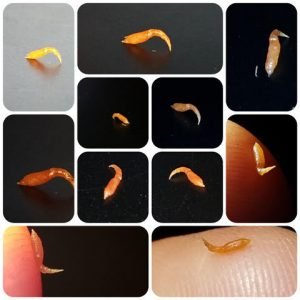
So, what exactly are wolf worms? They’re the larvae of a type of fly known as the **Cuterebra**, and they like to make their home in mammals, often targeting pets like cats and dogs. If you’re scratching your head wondering how these worms get into your beloved furry friend, you’re not alone! Let’s dive into the world of wolf worms, explore their seasonal patterns, and figure out what we can do to protect our pets.
What Are Wolf Worms?
Wolf worms, or **Cuterebra larvae**, are fascinating yet unsettling in their life cycle. These larvae can grow up to an inch long and typically enter their host through the skin, causing a nasty condition known as myiasis. If you’re thinking that sounds a bit like a horror movie plot, you’re not far off! The worms create a hole in the skin, allowing them to breathe while they grow.
These larvae are often found in outdoor environments, particularly in areas where rodents are common. They can also be found in grassy or brushy areas where pets like to roam. When adult flies lay eggs in or near these areas, the larvae can latch onto a passing animal. It’s a unique survival tactic that allows them to thrive, but it’s also a worrisome situation for pet owners.
You might be wondering how these worms affect your pet. Once inside, they can lead to infections and uncomfortable symptoms. The good news? We can often identify this issue early on with some basic knowledge about the signs and symptoms.
Signs of a Wolf Worm Infestation
Recognizing the signs of a wolf worm infestation in your pets can make a big difference in their health. So, what should you be looking for? Here are some common symptoms:
- Swelling or lumps on the skin, especially in the neck or face area.
- Excessive scratching or biting at the affected area.
- Foul odor coming from the site of infestation.
- Localized warmth or tenderness.
If you see any of these signs, it’s time to visit your veterinarian. An early diagnosis can lead to a quick treatment plan, which often involves removing the worm and administering antibiotics to prevent infection. Let’s face it: nobody wants their pet to be in discomfort, especially when something like a wolf worm could be the culprit.
Now, you might wonder how these infestations relate to seasonal patterns.
Seasonal Infestation Patterns of Wolf Worms
Understanding the seasonal patterns of wolf worms can help you be proactive in protecting your pets. Typically, **wolf worm infestations** peak during warmer months, especially from late spring through early fall. This is when their adult flies are most active in laying eggs.
During these seasons, your pets may come into contact with areas where flies are more likely to be buzzing around. It’s common for owners to notice issues during the summer when pets are frequently outdoors. If you’re an adventurous pet owner who loves to take your furry friend hiking or playing in the grass, keep this in mind!
You might also notice that infestations can vary by region. For example, warmer climates might see these flies thrive year-round, while colder areas might experience healthier populations only in the summer months.
Preventing Wolf Worm Infestations
Now that we understand what wolf worms are and their seasonal patterns, let’s talk about prevention. Here are a few tips to keep in mind:
- Keep your pets on a regular flea and tick prevention program. Many of these treatments also guard against other parasites.
- Avoid letting your pets roam freely in areas with high rodent populations.
- Regularly check your pets for any unusual lumps or sores, especially after outdoor adventures.
- Schedule routine veterinary check-ups to catch any issues early.
Being proactive about your pet’s health is the best strategy. It’s much easier to prevent an infestation than to deal with one once it happens!
Treatment Options for Wolf Worm Infestation
If you find that your pet has indeed been afflicted by wolf worms, don’t panic! There are treatment options available. The main course of action is to visit your veterinarian. They’ll likely remove the larvae through a simple procedure, which can often be done in the office.
Depending on the severity of the infestation, your vet may also prescribe antibiotics if there’s an infection present. It’s important to follow any aftercare instructions to ensure your pet heals properly.
Additionally, watch for any signs of discomfort or changes in behavior during recovery. Sometimes, pets can be a bit sensitive after treatment, and they might need an extra dose of love and care.
The Importance of Education
Understanding wolf worms and their seasonal patterns isn’t just about preventing infestations—it’s also about being educated pet owners. Knowledge is power. By knowing what to look for and how to protect your pets, you can avoid potential health issues and ensure they have a happy, healthy life.
Pet ownership comes with its challenges, but being informed can make all the difference. Think of it as equipping yourself with a toolbox of knowledge. The more you know, the better prepared you are!
Final Thoughts
In conclusion, wolf worms might be one of those topics that can make your skin crawl, but they’re a reality of pet ownership, especially during certain seasons. By keeping an eye on the signs, taking preventative measures, and acting quickly if you suspect an infestation, you can help your furry friends enjoy the outdoors safely. Remember, your veterinarian is your best ally in this journey. Together, you can keep your pets healthy and happy, ready for all the adventures that lie ahead!
